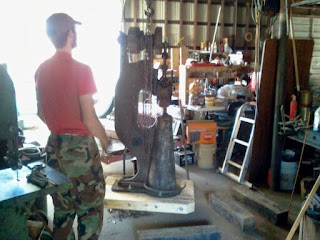Nov 11
After cleaning everything up and assessing the damaged
parts, it was time to start makin’ her look pretty again. I stopped at the hardware store to pick out
the color I want it to be. My initial
thought was a green as it had a green base color to it after I stripped it all
down. The final color ended up being Ace
Safety Blue. Next was to paint all the
parts, giving at least two coats to protect every bit of it.
The frame was the first thing painted. What a dramatic difference in appearance. It didn’t take long to see how good this
machine still looked.
Next I painted the flywheel or Faceplate. I can’t believe this is the same ships anchor
I found in the woods. A few of the other
parts were also painted safety blue.
While I was elbow deep in blue paint I talked to Roger from
littlegianthammer.com. He gave me the
only piece of history they had on it…the original Ship Date and Buyer.
No. 16 was shipped to F. Peterson of Madelia, Minn.
on Monday March 9, 1908. What a lucky
guy. Wish I knew what it did for most of
its life. I’m pretty sure Mr. Gene and
his father had it for 40-50 years.
Nov 12
I had to use a die grinder to get a couple of the parts free
of rust and grime. Completed painting
all the blue parts. Now I need a little
warm weather to paint all the smashy parts.
That would be the ram, toggle arms and the tread. The tread also needed to be beaten back into
shape as well as a mess of grinding to make it look good.
The rest of the night I spent racking a big double batch of
beer into 2- 5gal carboys and 1- 2gal carboy.
These will help me through the holidays.
Nov 14
The weather warmed up enough to paint some of the last
parts. I went with a gray for contrast
to the blue. Parts were ordered from littlegianthammer.com
and took drawings to a machinist to make 5 pins. When all the parts come in I will be able to pre-assemble
the hammer. The only thing it need is a
motor. I placed an ad on Craigslist to
find a used motor. We’ll see if that
pans out.
Nov 16 Homestead Work
Got a pic of the beast on the trail cam, a couple weeks ago,
that’s been tearing up my barn and eating all my cats food. Haven’t seen much of him lately. This morning I finally caught this big ol’
possum.
Ain’t he scary?
There were seven of us and it all went very fast. We dealt with one quarter at a time. Ribs and steaks were cut out of the quarters before we cut the rest.
Most of it was boned out and ground into burger or left
cubed for stew meat.
I was really surprised at how similar it was to butchering a
deer. Which I do myself a time or two
per season(Five times last year). The steer was on a different
scale though.
When we returned from the farm I dealt with Mr. Possum. His pelt was prime after all the cold weather
we’ve had. After skinning him I fleshed
the hide. This was not my first attempt at
fleshing but the first successful attempt.
If I was going to sell the hide I would have case skinned it, but I want
to put it out on my show table for people to touch. The hide was stretched on a flat board and
borax was rubbed into the flesh to preserve it.
After it dries it should last through years of shows



















